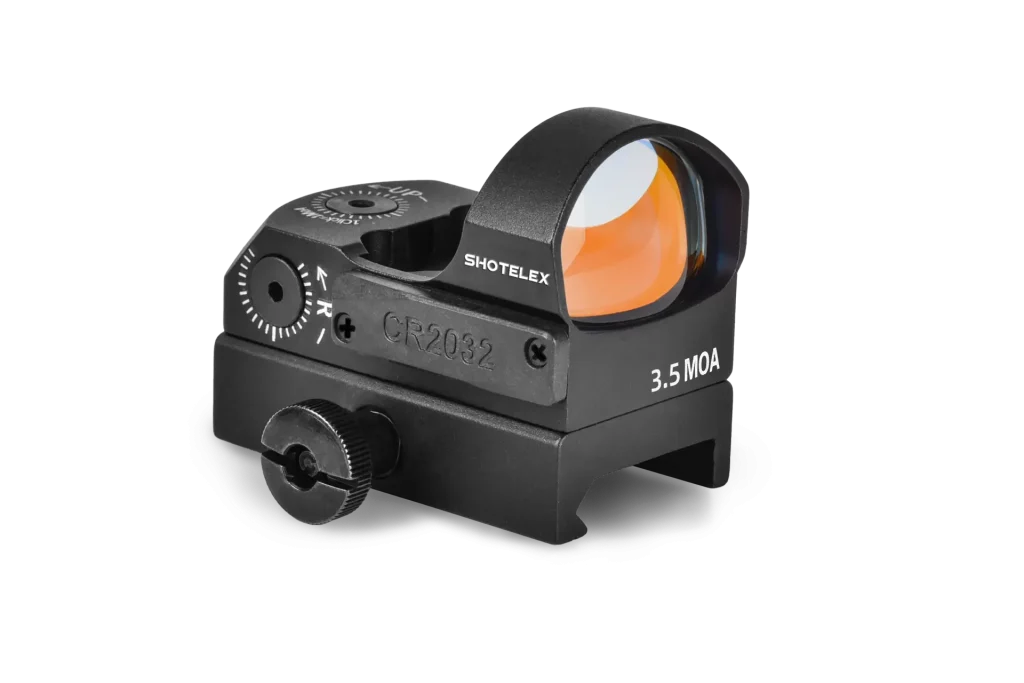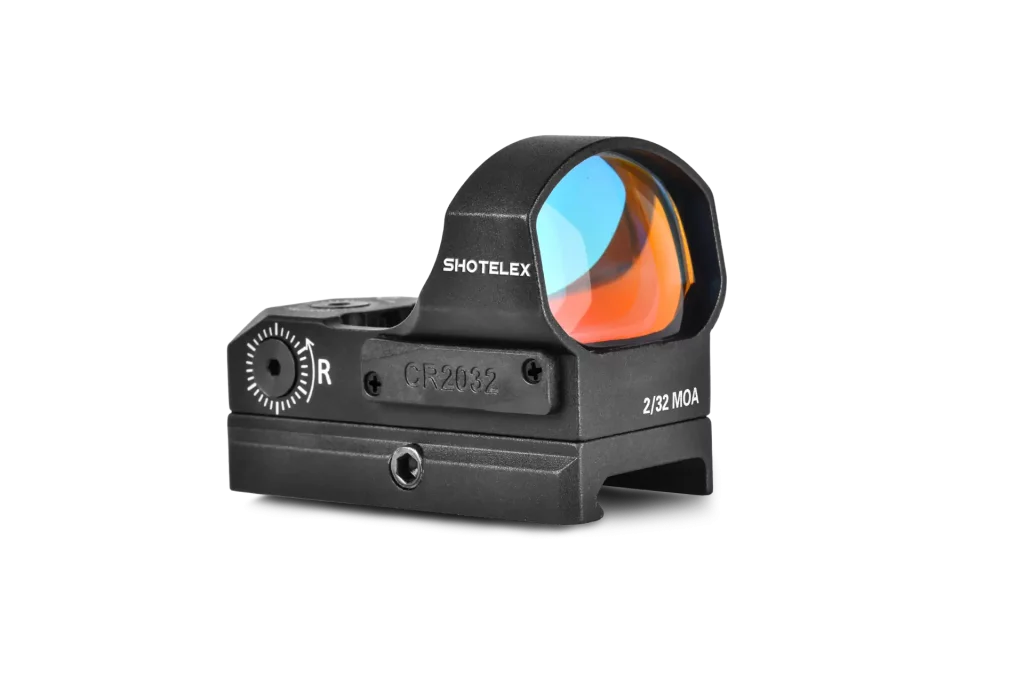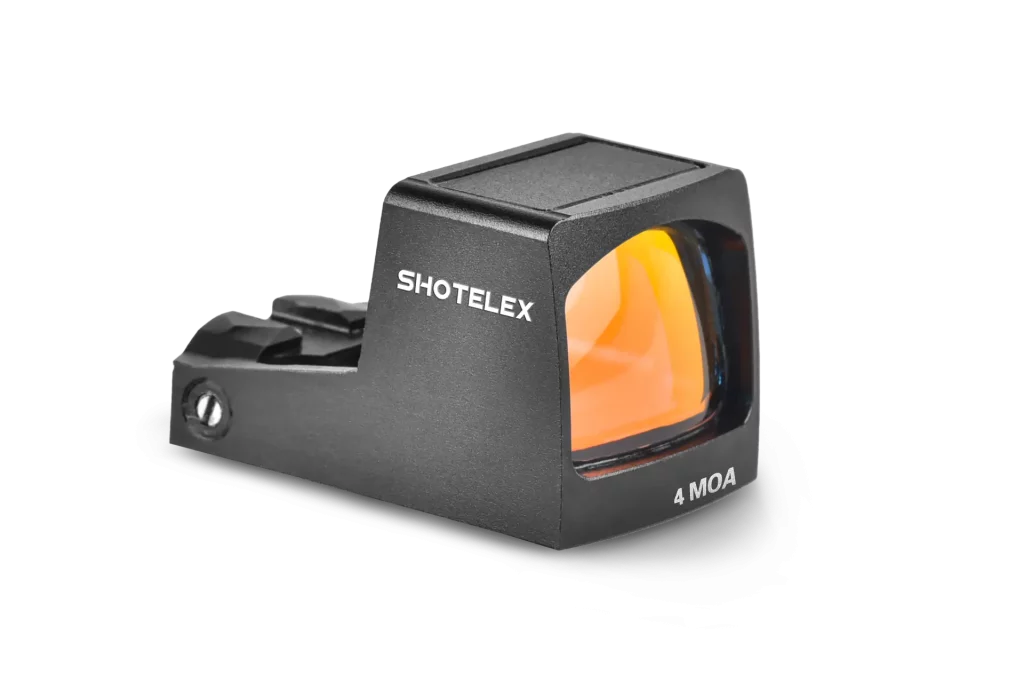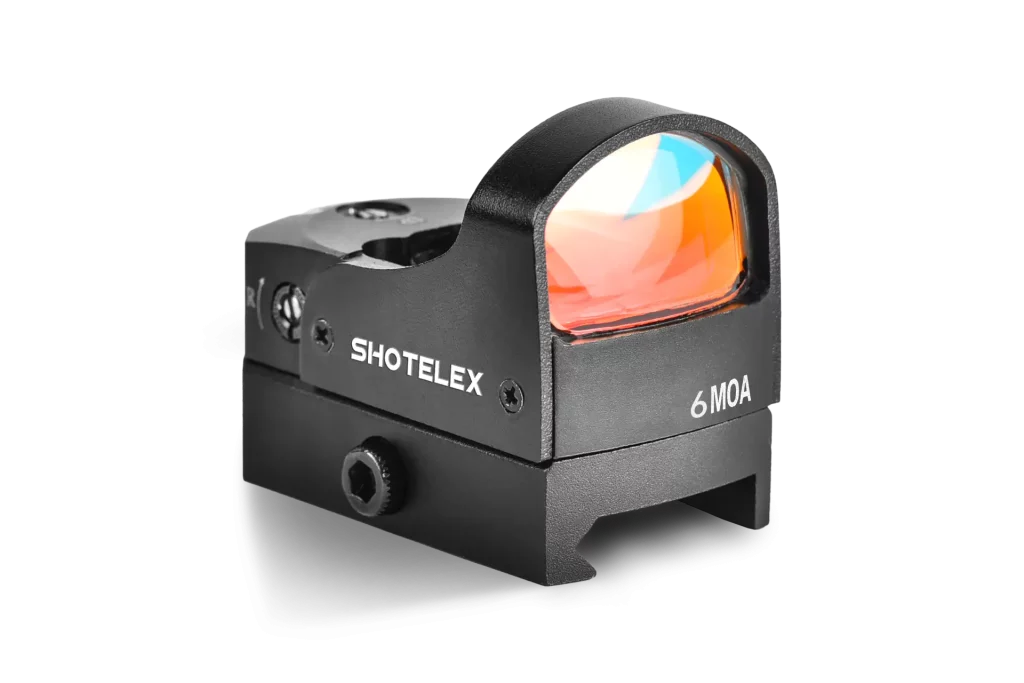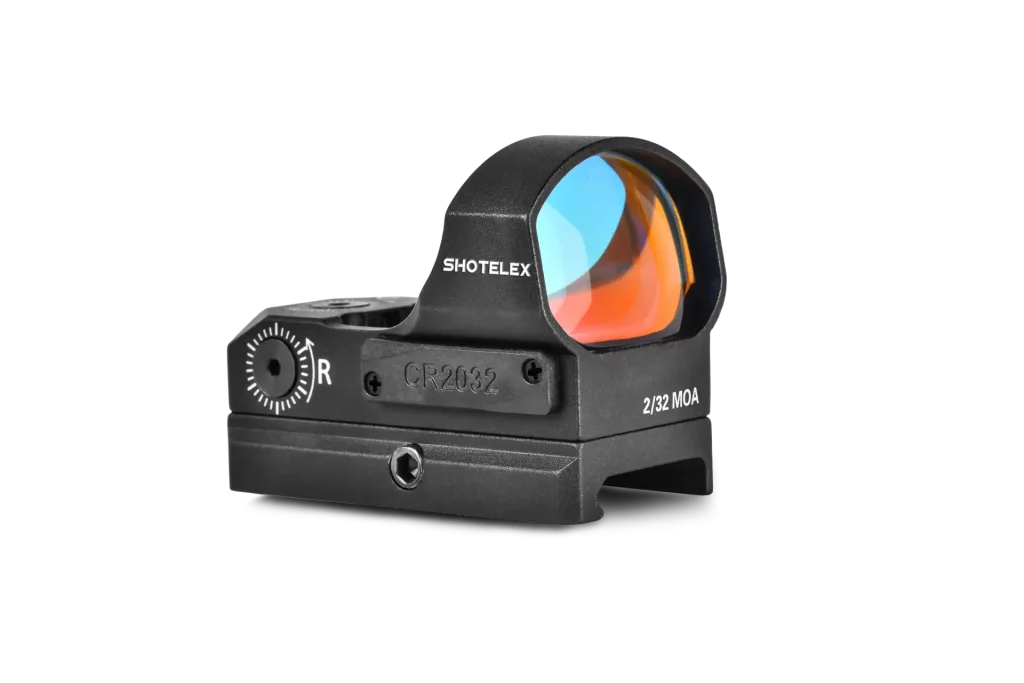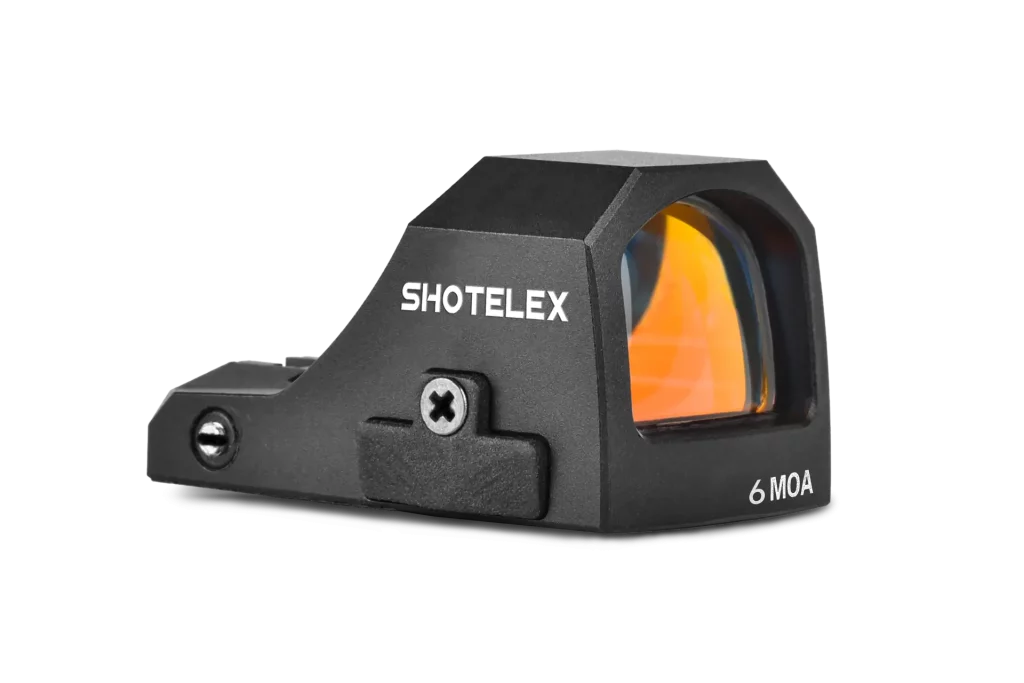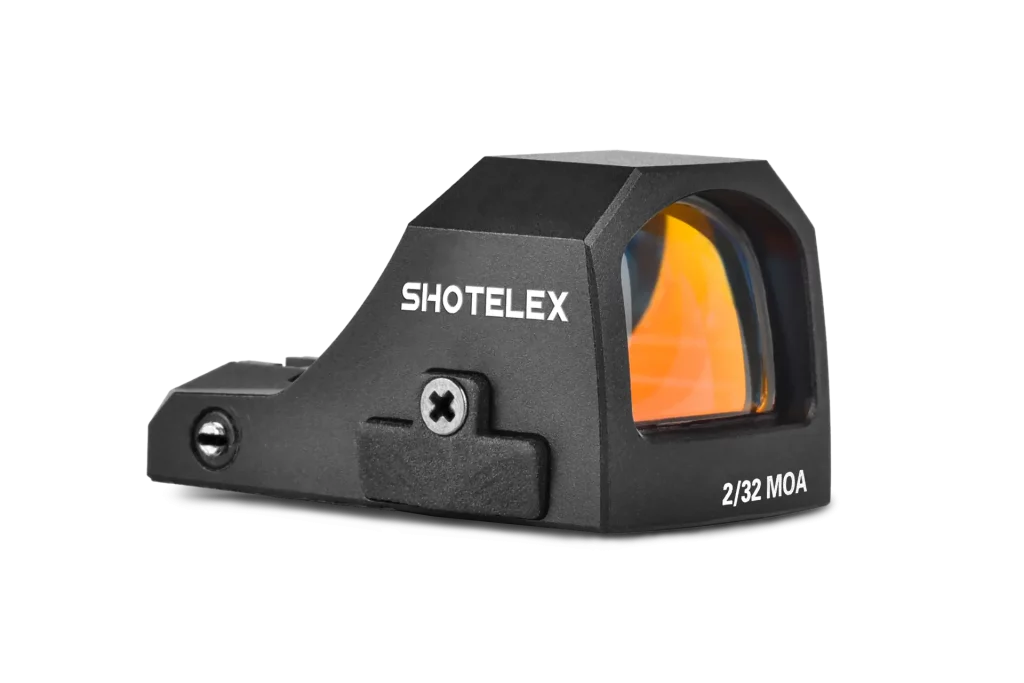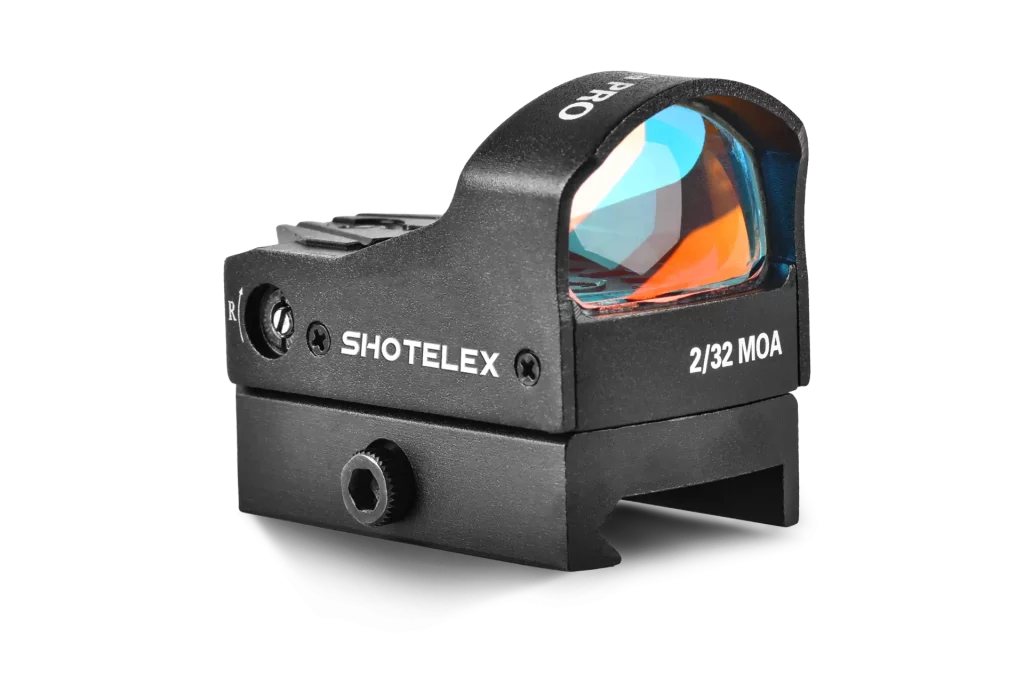Essential Rifle Hunting Scope Features and Their Functions
For hunting enthusiasts, the right rifle scope can make a world of difference in accuracy and comfort. A scope is more than a magnification tool; it is a precision instrument with features that can significantly impact your hunting success. Whether you’re hunting in dense woods or open plains, understanding the functions of each scope feature allows you to choose the best scope for your specific needs. This guide breaks down the essential features of rifle hunting scopes, so you can make an informed decision.
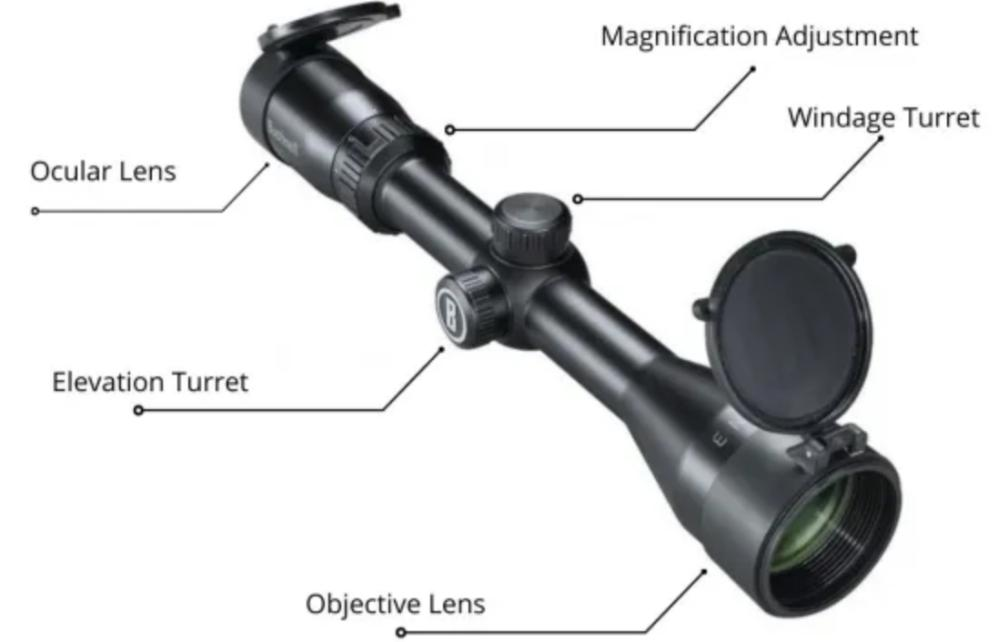
What is Magnification in a Rifle Hunting Scope
Magnification is a fundamental feature of any rifle hunting scope, determining how much larger a distant object appears in the scope’s viewfinder. It’s expressed as a ratio, such as 3-9×40, where the first number (3-9) indicates the variable magnification range, and the second number (40) represents the objective lens size in millimeters. Scopes are generally classified as either fixed or variable magnification.
Fixed vs. Variable Magnification
Fixed Magnification: These scopes have a single, non-adjustable magnification level, such as 4x or 6x. They are often simpler and more durable because they have fewer moving parts, which makes them reliable for rugged conditions. Fixed magnification scopes are often used for close-to-medium-range shooting, where a set level of zoom is sufficient.
- Advantages: Lighter, simpler, generally more robust. No need for adjustment, which makes them easy to use in quick situations.
- Disadvantages: Limited flexibility, as you’re restricted to a single magnification level.
Variable Magnification: These scopes offer a range of magnifications, such as 3-9x or 4-12x, allowing the shooter to zoom in and out. This flexibility is beneficial for hunters who may encounter targets at varying distances, from close to long range.
- Advantages: Versatile, as you can adjust to different distances. Ideal for hunting in varied environments where you need flexibility.
- Disadvantages: Heavier, more complex, and potentially more delicate due to moving parts. It requires manual adjustment, which might slow down a shot in quick situations.
Choosing the Right Magnification Level
- Low Magnification (1x-4x): Best for close-range hunting, such as in dense woods where animals are relatively close. Lower magnification provides a wider field of view, which is crucial for tracking moving targets and situational awareness.
- Medium Magnification (5x-9x): Suitable for moderate distances, where you may need more detail but don’t require extreme close-ups. This range is a good balance between field of view and target detail and is often a go-to for big game hunting.
- High Magnification (10x and above): Ideal for long-range hunting or precision shooting, where pinpoint accuracy is necessary. High magnification brings distant targets into clear view but can be less forgiving with movement, as the field of view narrows significantly. This range is often chosen by hunters targeting smaller game from far distances.
Factors to Consider for Magnification Choice
- Hunting Environment: Dense forests typically require low magnification for better peripheral vision, while open plains or mountainous areas benefit from higher magnification to spot and identify distant targets.
- Target Size: For larger animals, lower magnification is usually sufficient, whereas small games may require higher magnification for accuracy.
- Personal Preference: Some hunters prefer a fixed, lower magnification for simplicity and ruggedness, while others enjoy the flexibility of a variable scope. Comfort and experience with a specific type are key.
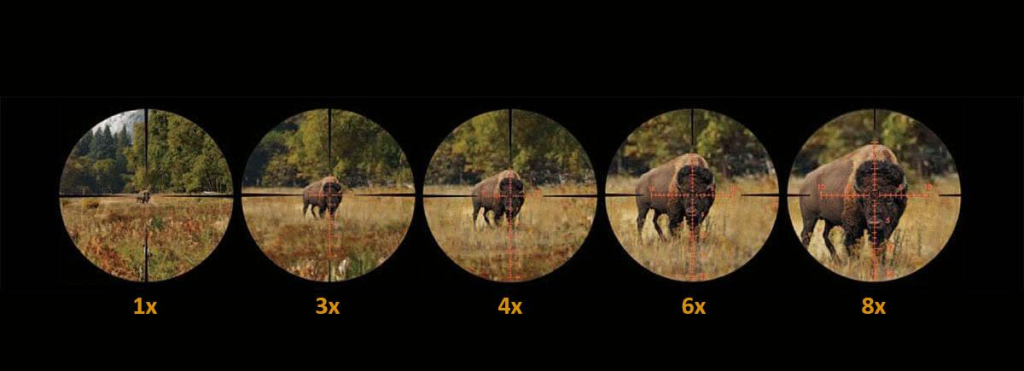
How Objective Lens Size in a Rifle Hunting Scope Impact Performance
What is the Objective Lens?
The objective lens is the front lens of a rifle scope and is responsible for gathering light. Its size, measured in millimeters, directly impacts the scope’s light transmission, image brightness, and clarity. Larger objective lenses gather more light, which can be especially beneficial in low-light conditions.
Impact of Objective Lens Size on Light Transmission
A larger objective lens allows more light to enter the scope, which improves brightness and clarity, particularly in low-light situations such as dawn or dusk when many animals are most active. More light transmission can make a significant difference in image quality, helping to distinguish details even in shadowed areas.
- Small Objective Lenses (20mm-32mm): Compact and lightweight, smaller objective lenses are suitable for hunters who prioritize mobility or who hunt in well-lit conditions. These lenses work well for close-range and low-magnification scopes.
- Medium Objective Lenses (40mm-44mm): Commonly used in hunting scopes, this size provides a good balance of light transmission and portability. A medium lens performs well in variable lighting conditions and is generally a good choice for general-purpose hunting.
- Large Objective Lenses (50mm and above): Larger objective lenses are favored for long-range and high-magnification scopes because they offer superior light-gathering capability. This advantage makes them ideal for low-light environments, but they also add weight and bulk to the setup, which can be a drawback for hunters who need to move quickly.
Choosing the Right Objective Lens Size
- Close to Mid-Range Hunting (20mm-44mm): For general hunting, especially at closer ranges and in well-lit environments, a smaller to medium objective lens will suffice. The reduced weight and lower mounting position make these scopes easier to handle in varied terrains.
- Long-Range and Low-Light Hunting (50mm and above): For those targeting distant games or hunting in low-light conditions, a larger objective lens can provide a significant advantage. The increased light gathering improves visibility in twilight hours, helping hunters identify their targets more clearly.
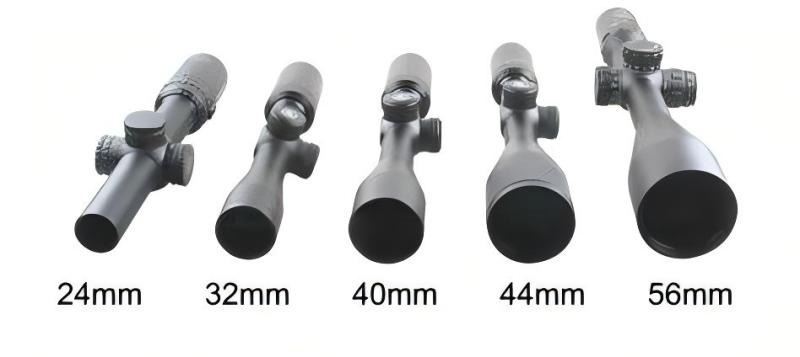
What is Eye Relief in a Rifle Hunting Scope?
Eye relief refers to the distance between the eyepiece and your eye while maintaining a full field of view. A comfortable eye relief not only enhances viewing comfort but also keeps your eye safe from recoil, especially in high-caliber rifles.
Factors Affecting Eye Relief
Several factors can impact eye relief in a rifle scope:
- Scope Magnification: In general, as magnification increases, eye relief tends to decrease. High-power scopes often have shorter eye relief because the increased magnification reduces the distance at which the image remains clear. This is something to keep in mind when considering scopes with variable magnification settings, especially if you plan to use the higher end of the magnification range.
- Type of Rifle and Caliber: Higher-recoil firearms require greater eye relief to avoid scope bite. Magnum calibers, like .300 Winchester Magnum or .338 Lapua, produce significant recoil and therefore benefit from scopes with extended eye relief. Conversely, low-recoil rifles, such as .22LR or .223 Remington, can comfortably be used with scopes that have shorter eye relief.
- Scope Design and Manufacturer: Different rifle scope manufacturers design their scopes with varying eye relief distances, even for similar magnification ranges. Some brands specialize in extended eye relief models, especially for hunting scopes. It’s always best to review the specific eye relief measurement for each scope model you consider, as this can vary significantly between brands and product lines.
Recommended Eye Relief for Different Hunting Setups
- Standard Hunting Rifles (Low to Moderate Recoil): For rifles with moderate recoil, such as .243 Winchester, 6.5 Creedmoor, or .308 Winchester, an eye relief of 3 to 4 inches is typically adequate. These scopes offer a good balance between comfort and visibility without the risk of scope bite.
- High-Recoil Rifles (Magnum Calibers): For rifles chambered in high-recoil calibers, like .30-06 Springfield or .300 Winchester Magnum, look for a scope with at least 4 inches of eye relief. Extended eye relief can offer added safety, especially if you’re shooting from awkward positions or in low-light conditions when you may be holding the rifle a bit looser.
- Handguns and Specialty Hunting Rifles: For long-eye-relief scopes often used on handguns or scout rifles, the eye relief can range from 8 to 20 inches. This allows shooters to hold the firearm further from their faces, ensuring safety and comfort, as these firearms often require a different shooting stance.
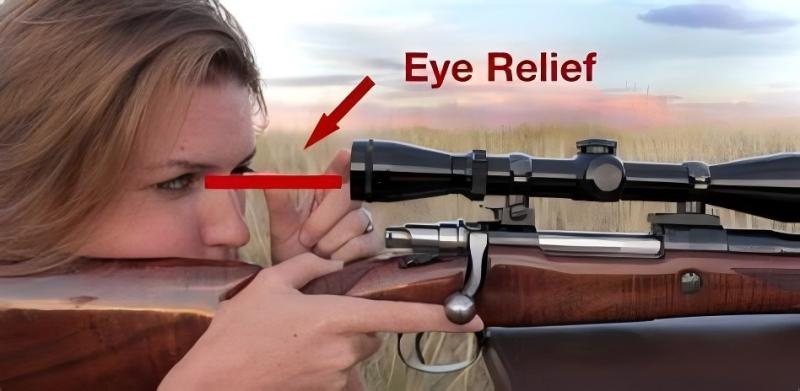
What is Parallax in a Rifle Hunting Scope?
Parallax in a rifle scope is a visual phenomenon that occurs when the reticle (crosshair) appears to shift in position against the target when you move your eye slightly off-center. This effect can cause aiming inaccuracies, especially at long distances or higher magnifications, because even a small shift in the reticle’s apparent position can result in a significant change in the point of impact on the target.
How Parallax Works in Scopes
In optics, parallax occurs because of the separation between the reticle’s focal plane and the image of the target. When the image and reticle are not aligned on the same focal plane, the reticle appears to “float” over the target and can seem to shift position as your viewing angle changes. Scopes with higher magnification and longer focal lengths are more susceptible to noticeable parallax, which can become a critical factor for precision shooters or hunters targeting distant games.
Parallax-Free Distance in Fixed Parallax Scopes
Some scopes, especially those designed for general hunting purposes, have a fixed parallax setting. This is commonly set at a particular distance, often around 100 or 150 yards. At this distance, the reticle and target image are aligned on the same focal plane, eliminating parallax error. However, at distances significantly closer or farther than this fixed setting, slight parallax may be noticeable.
For most hunting applications, especially for shots under 200 yards, a fixed parallax scope is generally adequate. However, if you hunt in varied terrains where both short and long-range shots are likely, or if precision at extreme distances is critical, a scope with adjustable parallax might be a better option.
Adjustable Parallax Scopes
Scopes with adjustable parallax, also known as “side focus” or “AO (Adjustable Objective)” scopes, allow the shooter to fine-tune the focus of the target image to align it perfectly with the reticle at varying distances. By adjusting the parallax control (usually a knob on the side of the scope or a ring on the objective lens), the user can eliminate parallax error at any given range.
Here’s how it works in different types of adjustable scopes:
- Side Focus Knob: This adjustment knob is typically located on the left side of the scope. It is convenient for quick adjustments while maintaining your shooting position, especially for long-range shooting.
- Adjustable Objective (AO): The AO is an adjustment ring on the objective lens itself, often marked with yardage increments to help set parallax accurately for specific distances. While AO scopes may require you to move your hand further to make adjustments, they are often highly precise and ideal for long-range hunting or target shooting.
When is Parallax Adjustment Necessary?
- Long-Range Shooting (Beyond 200 Yards): At greater distances, even a slight misalignment between the reticle and target image can result in a significant error in point of impact. Parallax adjustment becomes crucial for ensuring the reticle stays fixed on the target, improving accuracy.
- High-Magnification Scopes: Parallax error becomes more noticeable as magnification increases. At higher powers, the smallest shift in head position can cause the reticle to appear as if it’s moving relative to the target. If you plan on using a high-magnification scope (10x and above) for precise shots, adjustable parallax can help maintain accuracy.
- Small Targets or Precision Shooting: For hunters targeting small games or those needing high precision (such as varmint hunters), adjustable parallax helps lock in on the exact point of aim. In scenarios where even small shifts matter, like aiming at a small animal or shooting for a specific point on a large animal, minimizing parallax error can be the difference between a clean hit and a missed shot.
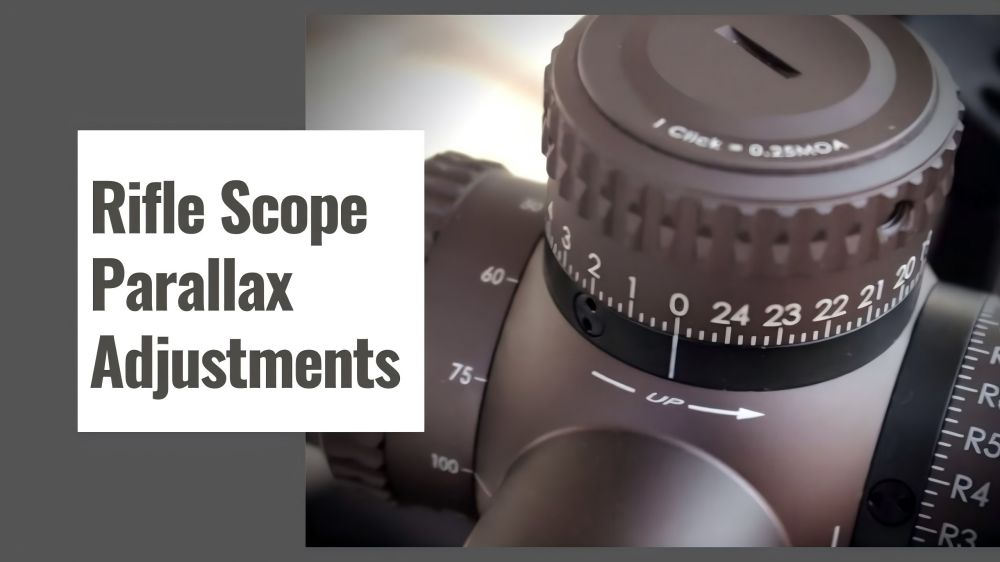
What are the Types of Reticles in a Rifle Hunting Scope?
The reticle, also known as the crosshair, helps you align your shot accurately. Reticles come in various designs, each suited to different hunting needs. Common reticle types include:
| Reticle Type | Description | Ideal For | Pros | Cons |
| Duplex Reticle | Simple crosshair with thick outer lines tapering to finer lines at the center, helping draw the eye toward the center. | General hunting, especially in low-light environments like dawn or dusk | Simple and easy to use; thicker edges quickly center the target, useful for big game hunting. | Limited range estimation; less suitable for long-range precision shooting. |
| Mil-Dot Reticle | Features evenly spaced dots on both vertical and horizontal lines for range estimation, windage, and holdover adjustments. | Long-range hunting, tactical shooting, varmint hunting requiring precise range estimation | Allows accurate range estimation and bullet drop compensation; ideal for experienced shooters needing precise adjustments. | Has a learning curve; requires knowledge of range estimation techniques, which may overwhelm beginners. |
| Bullet Drop Compensator (BDC) Reticle | Hash marks below the central crosshair indicate holdover points for various distances, compensating for bullet drop without manual turret adjustment. Typically calibrated for specific calibers and bullet weights. | Medium to long-range hunting; quick adjustments without manual turret adjustment | Simplifies long-range shots with clear holdover points; good for hunters not wanting to adjust settings manually. | Calibration can vary with ammunition type and environmental conditions; essential to confirm markings for specific rifle and load. |
| MOA Reticle | Uses hash marks (often 1 MOA) on crosshairs for precise windage and elevation adjustments based on angles, with each mark typically representing 1 inch at 100 yards. | Long-range and precision shooting, especially for shooters familiar with MOA | Offers precise measurement for accurate adjustments; beneficial for making accurate wind and elevation adjustments. | Requires knowledge and experience for effective use, similar to the mil-dot reticle. |
| Illuminated Reticle | Contains a light source (usually LED) illuminating reticle lines for better visibility in low-light conditions, ideal for dawn or dusk or aiming at dark targets. | Low-light conditions; complex, shadowed backgrounds | Enhances visibility in dim light, making aiming easier; some allow brightness adjustment to reduce glare. | May add weight and require batteries; bright illumination can be distracting. |
| Christmas Tree Reticle | Distinctive triangular pattern with dots and hash marks extending downward from the center to account for wind drift and bullet drop, ideal for long-range, windy conditions. | Long-range precision and tactical shooting, especially in variable wind conditions | Detailed holdover points for elevation and windage; excellent for highly accurate, long-range shots where wind is a factor. | Complex design may appear busy and challenging for beginners to use effectively. |
Choosing the Right Reticle for Your Hunting Style
1. Close-Range and Big Game Hunting
For hunters focused on big game at close to moderate ranges (typically under 200 yards), simplicity is key. A duplex reticle offers fast target acquisition and minimal distraction, which is ideal for quickly centering on game in brush or wooded areas. The thicker lines help guide the eye to the center, and the uncluttered design works well for fast-paced hunting situations.
2. Medium to Long-Range Hunting
For hunting across open fields or expansive areas where targets are at varying distances, a BDC or mil-dot reticle can be a great advantage. Both designs allow for quick range adjustments without needing to turn turrets, though mil-dot requires some knowledge of range estimation. A BDC reticle is often easier for those who want a “point-and-shoot” setup for hunting across different distances.
3. Long-Range Precision and Tactical Hunting
When extreme precision is required, such as in varmint hunting or target shooting at long distances, reticles that provide holdover and windage marks (such as the Christmas tree or MOA reticle) excel. These reticles are designed for precise adjustments based on environmental factors, allowing shooters to accurately account for bullet drop and wind drift without relying solely on scope adjustments.
4. Low-Light or Night Hunting
Hunters who often operate at dawn, dusk, or in heavily shaded environments may benefit from an illuminated reticle. This feature enhances visibility when the crosshairs might otherwise blend into the background, making it easier to maintain a clear sight picture in dim light. Adjustable brightness settings can help tailor the illumination to avoid glare and provide just the right amount of light.
Tips for Selecting a Reticle
- Match the Reticle to Your Shooting Needs: Each reticle has strengths suited to specific hunting styles and distances. Think about the types of animals you hunt, the typical ranges, and your comfort with range estimation when choosing a reticle.
- Consider Magnification Level: High-magnification scopes often reveal more detail in complex reticles (like mil-dot or Christmas tree), which can be beneficial at long range. However, at low magnifications, busy reticles can appear cluttered and obstruct your view of the target.
- Test for Personal Preference: If possible, test different reticles at a shooting range to see which design feels most natural and easy to use. A reticle that feels intuitive will help with faster target acquisition and more confident shooting.
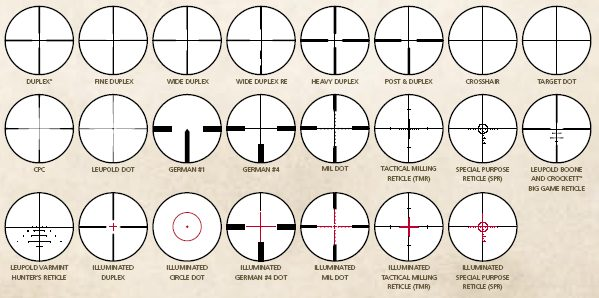
Additional Features to Consider
Besides the core features mentioned above, other aspects of a rifle scope can also affect your hunting experience.
- Turrets (Elevation and Windage Adjustments): These dials allow you to make precise adjustments to the point of impact. Elevation (up/down) and windage (left/right) adjustments are crucial for zeroing in your scope and making corrections based on range or environmental factors.
- Illumination: Some scopes offer illuminated reticles to improve visibility in low light. This feature can be particularly helpful during dawn or dusk, but keep in mind it may require battery power and brightness settings should be adjustable to avoid glare.
- Lens Coatings and Quality: Many scopes have multi-coated lenses, which reduce glare and improve light transmission, providing clearer images. Look for terms like “fully multi-coated” or “fully coated” for better lens performance and durability.
- Waterproofing and Durability: Modern hunting scopes are often waterproof, fog-proof, and shockproof. Look for scopes with sealed, nitrogen-purged, or argon-purged construction to withstand rough weather conditions and ensure a fog-free view. Durability is particularly important for outdoor hunting, where scopes are often exposed to harsh elements.
By understanding the functions of each feature, you can make an informed choice and choose a scope tailored to your needs. The right scope doesn’t just improve your aim—it enhances the overall hunting experience, giving you a clearer view, improved accuracy, and greater confidence in every shot. Whether you’re tracking the game at dawn or engaging in long-range shooting, a well-chosen scope can be the key to success in the field. customer support, and specialized features, you can confidently choose a riflescope that enhances your shooting experience and matches your unique requirements. Remember, a good scope not only elevates accuracy but also makes each outing more enjoyable and successful.

